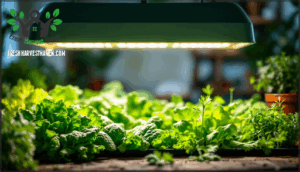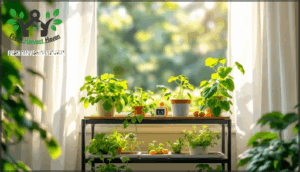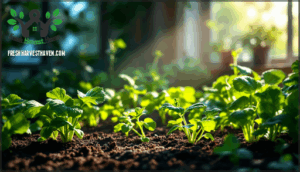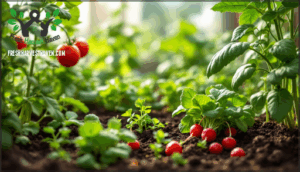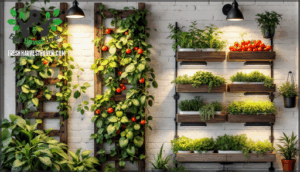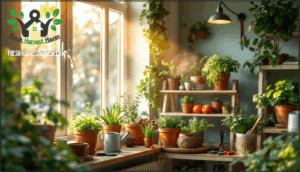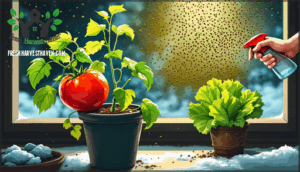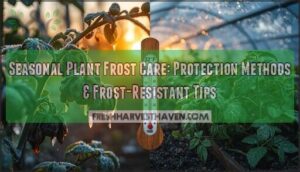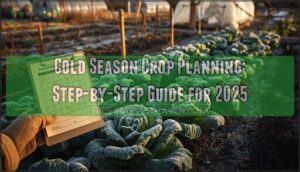This site is supported by our readers. We may earn a commission, at no cost to you, if you purchase through links.
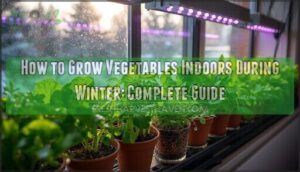
With the right setup, you can harvest crisp lettuce, peppery arugula, and fragrant herbs while snow piles up outside. Indoor winter gardening isn’t about replicating summer’s bounty; it’s about understanding what vegetables actually thrive under artificial conditions.
Most people assume they need a greenhouse or elaborate equipment, but a few strategic supplies and some basic horticultural knowledge will get you surprisingly far. The key lies in matching your environment to each plant’s specific needs—temperature, light spectrum, moisture levels—rather than fighting against winter’s constraints.
Table Of Contents
- Key Takeaways
- Essential Supplies for Indoor Winter Gardening
- Best Vegetables to Grow Indoors in Winter
- Setting Up Your Indoor Vegetable Garden
- Caring for Indoor Vegetables During Winter
- Overcoming Common Indoor Gardening Challenges
- Frequently Asked Questions (FAQs)
- What vegetables can you grow indoors in the winter?
- How many winter vegetables can you grow indoors?
- Can you grow vegetables indoors?
- Can you grow vegetables in winter?
- How do you grow a green plant in winter?
- Can you grow vegetables in cold weather?
- Can you grow vegetables indoors during the fall?
- Can you grow food indoors in winter?
- Can you grow vegetables indoors in the winter?
- What plants to grow indoors during winter?
- Conclusion
Key Takeaways
- Indoor winter gardening succeeds when you match plants to artificial conditions rather than trying to replicate outdoor summer growing—leafy greens, herbs, microgreens, and cold-hardy brassicas thrive indoors with 12-16 hours of grow lights, proper drainage, and temperatures around 60-70°F.
- Most failures stem from overwatering and poor container drainage rather than insufficient light, so use sterile potting mix with multiple drainage holes and check soil moisture two inches deep before watering again.
- Vertical growing techniques, succession planting every two weeks, and companion planting can triple your production in limited space while ensuring continuous harvests throughout winter instead of seasonal gaps.
- Pests and nutrient deficiencies cause the most damage when ignored—weekly leaf inspections, monthly soil pH testing, and quarter-strength fertilizer applications catch problems before they slash yields by up to 21%.
Essential Supplies for Indoor Winter Gardening
Before you start tossing seeds into any old pot, you’ll need to gather a few key supplies to give your indoor winter garden a real shot at success. The right containers, soil, lighting, and climate control can mean the difference between thriving plants and a disappointing mess.
Let’s break down what you actually need to get growing.
Choosing The Right Containers
Your container choice can make or break your indoor garden before you even plant a seed, so let’s talk about what actually works when you’re growing food inside during the coldest months. When picking the right containers for container vegetable gardening, focus on these five essentials:
- Container size: Match depth to root systems—leafy greens need 6 inches, root vegetables require 12 or more.
- Material types: Plastic retains moisture better than terracotta, which dries quickly in heated homes.
- Drainage needs: Multiple holes prevent waterlogged roots and subsequent rot.
- Space efficiency: Square containers pack tighter than round ones on windowsills.
- Aesthetic appeal: You’ll look at these daily, so choose containers you actually like.
Don’t skimp on drainage—it’s non-negotiable for container gardening success.
Soil Selection for Indoors
Once your containers are sorted, the soil you choose becomes the foundation that’ll either nourish your plants or leave them struggling through winter—and regular garden dirt from your backyard simply won’t cut it indoors.
Use a sterile potting mix, not dense potting soil—proper drainage needs and lightweight organic matter prevent root rot in containers.
Check soil pH (most vegetables prefer 6.0-7.0) and choose blends with decent nutrient density, since you’re creating artificial soil conditions from scratch.
Lighting Options and Setup
Winter light is a tough ask for vegetables—even your sunniest windowsill won’t give plants the intensity or hours they need to thrive indoors. You’ll need grow lights—LED lamps offer full light spectrum efficiency with lower energy consumption than fluorescent lamps, though both work fine for DIY setups.
Position your artificial light 4-6 inches above leafy greens, use timer settings for 12-16 hours daily, and adjust lamp placement as plants grow taller.
Temperature and Humidity Control
Most indoor gardeners obsess over light, but your plants will struggle—or worse, sulk into slow growth—if you ignore the air around them. Ideal temperatures hover around 60-70°F for most crops, though leafy greens tolerate cooler conditions. Humidity levels between 40-60% prevent wilting and fungal issues.
Air circulation from a small fan strengthens stems and discourages disease. Use simple monitoring tools like hygrometers to track indoor conditions, adjusting environmental control as seasonal adjustments shift your home’s baseline.
Best Vegetables to Grow Indoors in Winter
Not all vegetables are willing to forgive the dim, dry conditions of a winter home. The ones that will thrive indoors tend to share a few traits: they tolerate lower light, grow quickly, and don’t mind cooler temperatures.
Here’s what actually works when you’re growing food indoors during the cold months.
Leafy Greens and Salad Crops
Lettuce, spinach, and kale thrive indoors because they tolerate cooler temps and limited space—qualities that make growing leafy greens indoors surprisingly forgiving. You’ll want an ideal pH between 5.5 and 6.5 for hydroponic nutrients, paired with lighting strategies that deliver around 12 hours daily.
Variety selection matters: butter lettuce and arugula excel in containers, while salad greens like mixed baby leaves offer continuous harvests with solid water efficiency.
Research at MSU explores the viability of indoor farming for such crops.
Root Vegetables Indoors
Carrots, radishes, and even potatoes will surprise you with their adaptability when you give them proper soil depth—at least 12 inches for taproots to form without root deformities.
Growing root vegetables indoors demands consistent moisture and container spacing that prevents crowding, but lighting costs stay reasonable since they’re less light-hungry than fruiting crops.
Winter flavors actually intensify in carrots as cooler temps boost sugar content, rewarding your patience. However, be mindful that indoor gardening challenges can still impact your success.
Brassicas and Other Cold-Hardy Options
You’ve likely heard that growing vegetables indoors in winter is nearly impossible, but cold-hardy cultivars like ‘Winterbor’ kale and ‘January King’ cabbage defy that assumption.
Indoor germination of brassicas at 59-64°F sets you up for an extended harvest spanning 12-20 weeks, while pest reduction drops by over 90% compared to summer conditions.
Environmental optimization—60% humidity, bottom watering, and controlled temps—transforms leafy vegetables and other cold-hardy vegetables into reliable indoor vegetable gardening staples throughout winter.
Herbs and Microgreens for Indoors
If you think herbs demand a greenhouse and microgreens are too finicky for beginners, you’re about to discover why basil, cilantro, and arugula sprouts thrive with nothing more than a sunny windowsill and seven days of patience.
Indoor propagation of these high-yield crops delivers:
- Microgreen nutrition peaking at 4-6 times higher vitamin concentrations than mature plants
- Harvesting methods as simple as scissors and a plate—cut once at soil level
- Pest control reduced to near-zero through rapid 7-14 day growing cycles
Growing herbs indoors and growing microgreens demands minimal space but rewards you with consistent flavor.
Setting Up Your Indoor Vegetable Garden
Once you’ve picked your plants, the next step is setting up a space where they’ll actually thrive. Location, light, and layout all play a role in whether your indoor garden succeeds or just limps along.
Here’s how to get your setup right from the start.
Selecting The Ideal Growing Location
Your choice of location can make or break an indoor garden before you even plant a single seed. Start by evaluating light exposure—south-facing windows offer the best natural intensity during winter months. Temperature stability matters too; avoid drafty zones or spots near heating vents that create wild fluctuations.
| Factor | Ideal Condition | Warning Signs |
|---|---|---|
| Light Exposure | 6+ hours direct sun or grow lights | Leggy, pale growth |
| Temperature Stability | 60-70°F, minimal swings | Wilting, slow growth |
| Space Assessment | Room for containers + airflow | Crowded, tangled plants |
| Accessibility Factors | Easy watering/harvesting access | Neglected back corners |
| Environmental Control | Adjustable humidity, ventilation | Mold, dry leaf edges |
Consider accessibility factors—you won’t maintain plants tucked behind furniture. Space assessment helps determine container numbers and arrangement. Indoor gardening success hinges on matching your light requirements with what’s actually available, not what you wish you had.
Combining Sunlight and Artificial Light
Most indoor gardeners don’t realize that natural light alone—even from the best window—won’t cut it for productive winter growth, which is where strategic artificial supplementation saves your harvest. Position grow lights to eliminate shadow management issues while matching the light spectrum your crops need.
Run them 12-14 hours daily for proper light duration, adjusting plant positioning to balance sunlight with indoor lighting for plants. This combo maximizes light intensity without sacrificing energy efficiency.
Arranging Plants for Space Efficiency
Cramming vegetables into every available nook sounds like a good plan until your tomato plant sprawls over your lettuce and nothing gets enough light to produce a decent yield. Group plants by height—taller ones behind shorter crops—to improve light distribution.
Use companion planting principles: pair fast-growing radishes with slower spinach. Staggered planting schedules keep your indoor garden producing vegetables indoors all winter without creating a congested mess where nothing thrives.
Vertical Gardening Techniques
When floor space runs out, walls and uprights become your next frontier for squeezing more production from the same square footage. Trellises, wall-mounted planters, and tiered shelving transform empty vertical space into productive zones for growing vegetables indoors during winter.
- Lightweight vining crops like peas and trailing herbs climb trellises, freeing floor space for compact greens
- Hanging planters work well for cherry tomatoes and cascading herbs with adequate lighting placement above
- Stackable shelving units with individual grow lights get the most out of space in tight quarters
- Pocket planters mounted on walls hold microgreens and lettuce without bulky support structures
Caring for Indoor Vegetables During Winter
Getting your indoor garden started is one thing, but keeping those plants thriving through the darker, drier winter months takes a different kind of attention. The conditions inside your home during winter can stress vegetables in ways you mightn’t expect—from fluctuating humidity to inconsistent watering rhythms.
Here’s what you need to focus on to keep your indoor crops healthy and productive until spring arrives.
Watering and Humidity Management
Overwatering kills more indoor vegetables than any other mistake, yet most gardeners worry they’re not watering enough—a paradox that stems from misunderstanding how container plants actually use moisture.
Overwatering kills more indoor vegetables than any other mistake, yet most gardeners worry they’re not watering enough
Check soil moisture by sticking your finger two inches down; if it’s dry there, water thoroughly until drainage appears.
Indoor winter air tends toward dryness, so boost humidity around leafy greens with pebble trays or gentle misting, which helps prevent crispy leaf edges without risking root rot.
Fertilizing Indoor Plants Properly
Plants confined to pots can’t forage for nutrients the way garden soil dwellers do, so you’ll need to feed them—but less is genuinely more regarding fertilizer indoors. Dilute liquid fertilizer to quarter-strength and apply every two weeks, since potting soils lack the buffering capacity of garden earth.
Organic options like fish emulsion work beautifully for leafy greens, meeting their nitrogen needs without the salt buildup that synthetic fertilizers can cause in containers.
Pollination and Pruning Tips
If you’re growing fruiting plants like tomatoes or peppers, you’ll need to play the part of the bee—because there aren’t any buzzing around your living room to do the job for you. Hand pollination is straightforward:
- Gently tap flowering stems daily to release pollen
- Use a small brush to transfer pollen between blossoms
- Keep humidity moderate to prevent blossom drop and encourage fruit set
Pruning techniques matter too—trim leggy growth and pinch back excessive foliage to direct energy toward production, not just leafy sprawl.
Monitoring Plant Health and Growth
Keeping a watchful eye on your indoor crops isn’t just about glancing over when you water—it’s about learning to read the subtle signals your plants send before minor hiccups turn into full-blown disasters. Check leaf color and growth rate weekly—yellowing or stunted vigor often points to fertilizing needs or poor growing conditions.
Inspect stems for pest detection, and occasionally peek at roots to confirm plant health remains strong.
Overcoming Common Indoor Gardening Challenges
Even with the right setup, indoor gardens throw a few curveballs—pests that sneak in, plants that look pale and hungry, or containers that feel way too small for your ambitions.
The good news is that most problems have straightforward fixes once you know what to look for. Let’s walk through the most common hiccups and how to address them without losing your mind.
Managing Pests and Disease Prevention
Your indoor garden isn’t immune to trouble—stressed plants attract aphids, spider mites, and fungal problems. Prevention beats treatment: control humidity to avoid root rot, inspect leaves weekly for pest identification, and use organic controls like neem oil or insecticidal soap.
Winter challenges include dry air and poor circulation, so improve airflow while maintaining steady moisture. Controlling pests indoors means catching them early, keeping plant health strong, and never letting issues spiral.
Solving Nutrient Deficiencies
Yellowing leaves and stunted growth signal something’s missing—nutrient deficiencies can steal up to 21% of your winter harvest if ignored. Here’s how to diagnose and fix the problem:
- Check for nitrogen deficiency (yellowing lower leaves)—present in 37% of indoor crops
- Test soil pH monthly—wrong pH blocks nutrient uptake by 45%
- Apply diluted fertilizer at quarter-strength to avoid overfeeding
- Use foliar sprays for iron or manganese issues—symptoms improve in 7-10 days
- Add organic matter like compost to boost magnesium availability by 25%
Soil testing reveals what your plants actually need, not what you think they need. Address deficiencies promptly with targeted fertilizing strategies—whether organic fertilizer or hydroponic solutions—to restore plant health before yields suffer.
Maximizing Yields in Limited Space
Every square inch of your indoor garden is potential. Smart spacing and vertical techniques can triple production without needing a bigger footprint. Stack containers vertically, train vining crops upward, and pair fast-growing microgreens with slower leafy greens through companion planting.
Strategic pruning keeps plants compact while light optimization guarantees lower leaves still photosynthesize. Nutrient cycling from harvesting vegetables indoors feeds successive crops, turning your winter setup into a perpetual production line.
Year-Round Harvest and Succession Planting
Think of succession planting as your insurance policy against the February doldrums—you stagger sowings every two weeks so that while one crop matures, another’s already hitting its stride. Staggered planting guarantees a continuous harvest without gaps, rotating fast growers like microgreens between slower kale cycles.
This maximizing yield approach transforms winter growing vegetables indoors into a genuine year-round harvest, where harvesting vegetables indoors becomes routine rather than seasonal. Crop rotation prevents nutrient depletion, extending your season indefinitely.
Frequently Asked Questions (FAQs)
What vegetables can you grow indoors in the winter?
Cool-season crops thrive best when growing vegetables indoors during winter. Leafy greens like lettuce, spinach, and kale lead the pack, alongside quick-growing microgreens and herbs indoors.
Root crops like radishes and brassicas such as arugula also perform remarkably well in indoor gardening setups.
How many winter vegetables can you grow indoors?
You can grow quite a few options indoors during winter—leafy greens, microgreens, herbs, radishes, even potatoes from scraps.
Space constraints and light requirements matter more than variety when growing vegetables indoors, but temperature sensitivity and yield expectations help narrow your choices.
Can you grow vegetables indoors?
Yes, you can grow vegetables indoors—it’s like bringing a productive garden into your living room.
With basic shop lights, proper containers, and the right plant selections, home gardening transforms any sunny corner into a year-round harvest space.
Can you grow vegetables in winter?
Winter vegetable growth is absolutely possible—even outdoors in some climates—but indoor gardening offers distinct advantages. Indoor climate control, proper lighting requirements, and smart variety selection let you bypass frozen ground and short days.
Space limitations matter less when you’re growing vegetables indoors during winter, turning any sunny corner into productive garden space with the right winter gardening tips.
How do you grow a green plant in winter?
You’ll want adequate artificial light—most greens need 12-14 hours daily—plus consistent temperatures around 60-70°F and humidity management.
Choose cool-tolerant varieties like lettuce, spinach, or kale for indoor gardening success during winter.
Can you grow vegetables in cold weather?
Absolutely. Cold-hardy vegetables like kale, spinach, and Brussels sprouts thrive in winter conditions outdoors, tolerating frost with ease.
Indoor microclimates and season extension techniques help cold-weather crops flourish even when winter sunlight is limited.
Can you grow vegetables indoors during the fall?
Autumn doesn’t wait for permission—your tomatoes and peppers certainly won’t either. Fall vegetable varieties thrive with indoor gardening setups, especially as seasonal light changes demand grow lights.
Temperature fluctuations stay manageable indoors, while pest lifecycle timing becomes less problematic than outdoors.
Can you grow food indoors in winter?
You can grow food indoors in winter using basic shop lights and minimal space. Beginner crops like leafy greens thrive with proper lighting needs, making offseason gardening viable despite space constraints in apartments.
Can you grow vegetables indoors in the winter?
Despite what the calendar suggests, you don’t need to surrender your harvest when frost arrives. Indoor gardening allows offseason gardening success with proper light, climate control, and space considerations—leafy greens, herbs, and certain root vegetables thrive inside throughout winter months with minimal fuss.
What plants to grow indoors during winter?
Leafy greens like lettuce and spinach top the list for growing vegetables indoors during winter, followed by root vegetables such as radishes, cold-hardy brassicas like kale, and herbs or microgreens that thrive year-round.
Conclusion
You’ve probably heard that growing vegetables indoors during winter is too complicated for average gardeners—but that’s only true if you ignore what plants actually need. Once you match light intensity to growth stage, control humidity without overwatering, and choose crops adapted to confined spaces, your kitchen counter becomes surprisingly productive.
Growing vegetables indoors during winter isn’t about mimicking outdoor conditions; it’s about engineering a microclimate where leafy greens and herbs outperform their summer counterparts. Your first harvest will prove it: fresh beats frozen, every time.

